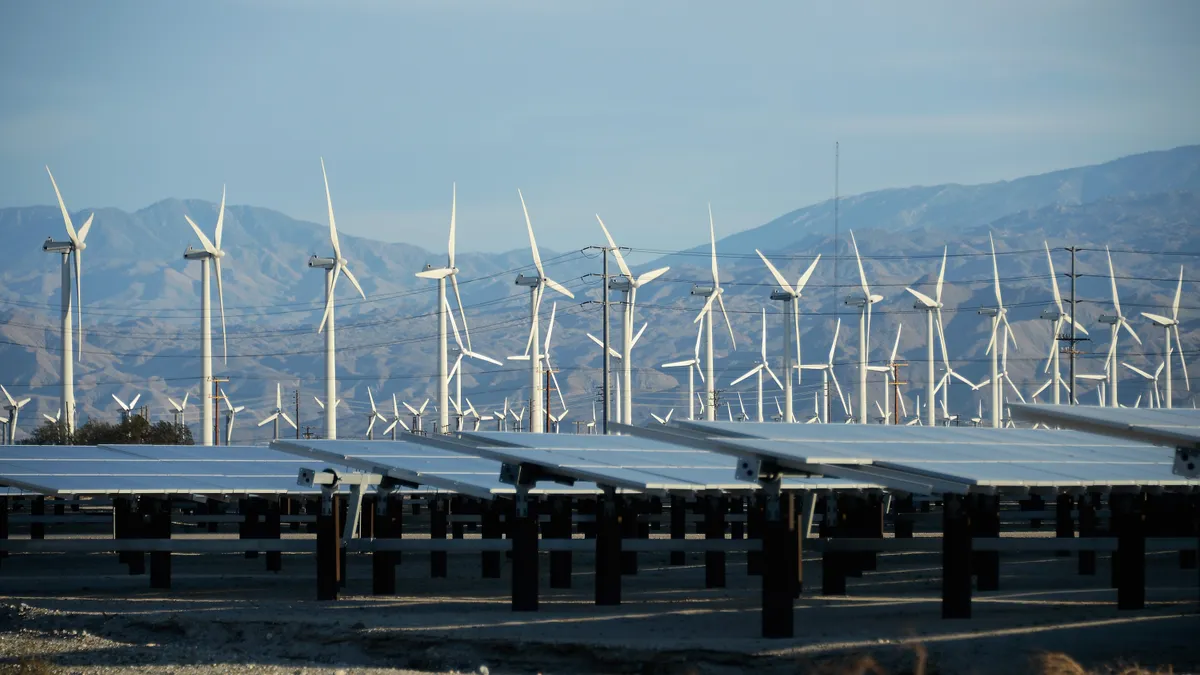Dive Brief:
- California regulators on Tuesday unveiled a new version of their proposal to procure 11.5 GW of electricity resources to support the state's grid after the Diablo Canyon nuclear plant and several natural gas plants are retired, this one without any fossil fuels.
- The California Public Utilities Commission (CPUC) had previously released two proposed decisions on the procurement package, which would have included between 500 MW and 1,500 MW of gas resources. But regulators this week scrapped one proposal and altered the other to make it 100% greenhouse gas-free. Commissioners will vote on the new version on Thursday.
- An 11.5 GW clean energy procurement package would set the stage for California's broader energy transition, according to Tyson Siegele, an energy analyst with the Protect Our Communities Foundation. "[It] is a good initial down payment, but it is far short of where we ultimately need to be. And so I think that we're going to see a lot more of these types of procurements in the future," he said.
Dive Insight:
The proposed procurement is intended in part to help replace California's 2.2 GW Diablo Canyon nuclear facility, slated to retire by 2025, as well as multiple natural gas plants that are also scheduled to go offline in the near future. One initial version of the proposed decision authorized between 1,000 MW and 1,500 MW of natural gas resources as part of the package, while the other included 500 MW of gas resources, to be procured by the state's investor-owned utilities.
But the inclusion of natural gas in the proposals prompted concerns from environmental groups and others. At an all-party meeting last week, CPUC Commissioner Martha Guzman Aceves asked stakeholders to weigh in on whether the commission should place geographic restrictions on the fossil fuel procurement, or even defer the question of including fossil fuels to a later stage.
The new version of the proposed decision would still call for 11.5 GW of additional net qualifying capacity to be procured from 2023 through 2026. However, it would not allow any additional capacity from fossil fuel resources.
"[I]n response to comments from numerous parties on the proposed decision representing a broad spectrum of viewpoints, we find that we would like additional analysis of the reliability impacts before requiring additional fossil-fueled capacity procurement," the proposed decision stated.
The CPUC intends to work with the California Energy Commission in the next few months to conduct that analysis for a future decision expected to come out later this year, and may consider additional capacity procurement requirements at that point, regulators said in the proposal.
The new version of the proposed decision also adjusts the timing of the procurement, from 3,000 MW by 2023 and 4,500 MW by 2024, to 2,000 MW by 2023 and 6,000 MW by 2024. An additional 1,500 MW by 2025 and 2,000 MW by 2026 would round off the entire package. Those adjustments came in response to comments from stakeholders who questioned whether there was a reliability need in 2023.
The Protect Our Communities Foundation welcomed the decision as embracing the idea that California doesn't need incremental fossil fuel procurement.
"Having said that, it does leave the door open to future procurement of fossil fuels, but it says the commission is going to take a look at what's needed, what the modeling says, and make decisions based on that," Siegele said.
But the revised proposal could have other implications, including for California's ability to meet system needs during the net peak, when solar energy is coming off the system, according to Seth Hilton, partner at Stoel Rives. Fossil fuel resources were one option to fill that gap, and regulators will now need other resources, including potentially storage.
And while regulators plan to revisit the question of fossil fuel procurement later this year, "one of the challenges they'd have is the later they push this, the longer it's going to take to get the fossil fuel resources in place," Hilton explained. Even just repowering or expanding existing gas facilities involves extensive permitting processes, he said, and there's the risk the resources might not be able to come online when needed.
Looking at California's portfolio of electricity resources, natural gas is being used less to supply energy during the middle of the day but is essential to meet the net peak, or during very hot periods, Jan Smutny-Jones, CEO of the Independent Energy Producers Association, said.
"California is going to need to be very vigilant that it is not prematurely shutting down resources that it ultimately will need," Smutny-Jones said. The state should try to maintain resources that can be available to meet reliability needs, while at the same time bringing online new resources, like solar with storage, he added.














